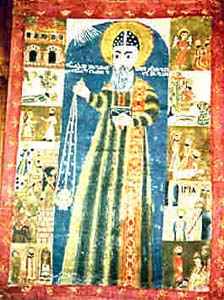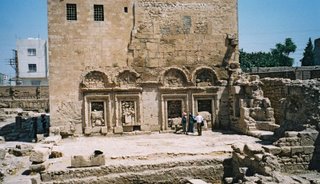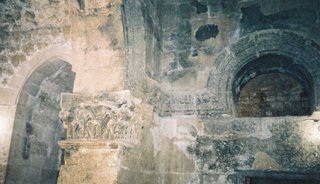
When it came time to name my son I suggested to my wife that one of his middle names be Ephraim, after a great Syrian saint. The name means 'fruitful' or 'prosperous' in its Hebrew etymology and I thought that was a very strong reason for giving my son this as one of his middle names. I am glad Ramone agreed, though her reasons were founded more on the great spiritual insight found in the Lenten prayer composed by St. Ephraim:
O God, cleanse me, a sinner.
O Lord and Master of my life,
take from me the spirit of laziness,
despair, lust for power and idle talk.
But rather the spirit of chastity, humility,
patience and love to your servant.
Yea, O Lord and King,
grant me to see my own sins
and not to judge my brother:
for you are blessed
unto the ages of ages.
O God, cleanse me, a sinner.
Amen.
My favourite line of Saint Ephraim's is from his second of nineteen Hymns on the Nativity of Christ in the Flesh, wherein he writes: "Blessed be the Fruit, Who lowered Himself to fulfill our hunger!" What literary critic would not be drop-jawed at that figure of speech?!
One of St. Ephraim's re-occurring figures of speech is that of Christ as painting a self-image. Speaking of the Jewish law, the Gospels, and nature, he wrote:
You have mixed them together as paints for
your portrait; you have looked at yourself,
and painted your own portrait.
Here is the painter, who in himself has painted
his Father's portrait,
two portrayed, the one in the other...
you in your coming brought it to completion.
Here are a couple photos of the church to which St. Ephraim devoted so much of his energy and a snippet from Wikipedia on St. Ephraim:


Ephraim was born around the year 306, in the city of Nisibis (the modern Turkish town of Nusaybin, on the border with Syria). Internal evidence from Ephraim's hymnody suggests that both his parents were part of the growing Christian community in the city, although later hagiographers wrote that his father was a pagan priest. Numerous languages were spoken in the Nisibis of Ephraim's day, mostly dialects of Aramaic. The Christian community used the Syriac dialect. Various pagan religions, Judaism and early Christian sects vied with one another for the hearts and minds of the populace. It was a time of great religious and political tension. The Roman Emperor, Diocletian had signed a treaty with his Persian counterpart, Nerses in 298 that transferred Nisibis into Roman hands. The savage persecution and martyrdom of Christians under Diocletian were an important part of Nisibene church heritage as Ephrem grew up.
Jacob, the first bishop of Nisibis was appointed in 308, and Ephraim grew up under his leadership of the community. Jacob of Nisibis is recorded as a signatory at the First Council of Nicea in 325. Ephraim was baptized as a youth, and almost certainly became a son of the covenant, an unusual form of Syrian proto-monasticism. Jacob appointed Ephraim as a teacher (Syriac malp̄ānâ, a title that still carries great respect for Syriac Christians). He was ordained as a deacon either at his baptism or later. He began to compose hymns and write biblical commentaries as part of his educational office. In his hymns, he sometimes refers to himself as a 'herdsman' (`allānâ), to his bishop as the 'shepherd' (rā`yâ) and his community as a 'fold' (dayrâ). Ephraim is popularly credited as the founder of the School of Nisibis, which in later centuries was the centre of learning of the Church of the East.
In 337, Emperor Constantine I, who had legalised and promoted the practice of Christianity in the Roman Empire, died. Seizing on this opportunity, Shapur II of Persia began a series of attacks into Roman North Mesopotamia. Nisibis was besieged in 338, 346 and 350. During the first siege, Ephraim credits Bishop Jacob as defending the city with his prayers. Ephraim's beloved bishop died soon after the event, and Babu led the church through the turbulent times of border skirmishes. In the third siege, of 350, Shapur rerouted the River Mygdonius to undermine the walls of Nisibis. The Nisibenes quickly repaired the walls while the Persian elephant cavalry became bogged down in the wet ground. Ephraim celebrated what he saw as the miraculous salvation of the city in a hymn which portrayed Nisibis as being like Noah's Ark, floating to safety on the flood.
One important physical link to Ephraim's lifetime is the baptistery of Nisibis. The inscription tells that it was constructed under Bishop Vologeses in 359. That was the year that Shapur began to harry the region once again. The cities around Nisibis were destroyed one by one, and their citizens killed or deported. The Roman Empire was preoccupied in the west, and Constantius and Julian, struggled for overall control. Eventually, with Constantius dead, Julian the Apostate began his march into Mesopotamia. He brought with him his increasingly stringent persecutions of Christians. Julian began a foolhardy march against the Persian capital, Ctesiphon, where, overstretched and outnumbered, he was forced into an immediate retreat back along the same road. Julian was killed defending his retreat, and the army elected Jovian as the new emperor. Unlike his predecessor, Jovian was a Nicene Christian. He was forced by circumstances to ask for terms from Shapur, and conceded Nisibis to Persia, with the provision that the city's Christian community would leave. Bishop Abraham, the successor to Vologeses, led his people into exile.
Ephraim found himself among a large group of refugees that fled west, first to Amida (Diyarbakır), and eventually settling in Edessa (modern Şanlıurfa) in 363. Ephraim, in his late fifties, applied himself to ministry in his new church, and seems to have continued his work as a teacher, perhaps in the School of Edessa. Edessa had always been at the heart of the Syriac-speaking world and the city was full of rival philosophies and religions. Ephraim comments that Orthodox Nicene Christians were simply called 'Palutians' in Edessa, after a former bishop. Arians, Marcionites, Manichees, Bardaisanites and various Gnostic sects proclaimed themselves as the true church. In this confusion, Ephraim wrote a great number of hymns defending Nicene Orthodoxy. A later Syriac writer, Jacob of Serugh, wrote that Ephraim rehearsed all-female choirs to sing his hymns set to Syriac folk tunes in the forum of Edessa. After a ten-year residency in Edessa, in his sixties, Ephraim succumbed to the plague as he ministered to its victims. The most reliable date for his death is 9 June 373.

1 comment:
Thanks Thomas. It's good to learn more about the man whose prayer we pray.
I've loved the name Ephraim for a long time.
Post a Comment